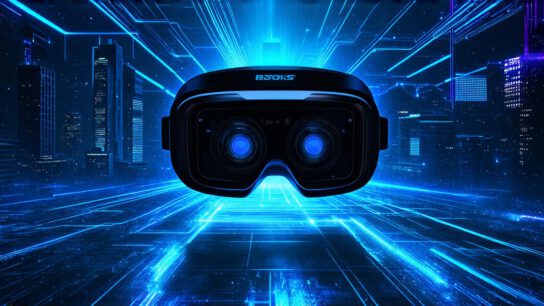The Dawn of Virtual Reality: Ancient Dreams and Illusions
The concept of virtual reality dates back thousands of years, with roots in ancient mythology and art. For example, the ancient Greeks used mirrors to create illusions that made it seem like the viewer was standing in a different place or time. Similarly, in Chinese art, painting techniques known as “foreshortening” and “perspective” were used to create realistic-looking representations of three-dimensional space.
The first recorded use of virtual reality technology dates back to 1962 when American psychologist Ivan Sutherland created the first VR headset using a cardboard box, two projectors, and a pair of mirrors. This early system, known as the “Sword of Damocles,” allowed users to experience a virtual environment by looking through two separate screens that were aligned at eye level.
In the following years, several pioneers in VR technology continued to push the boundaries of what was possible. For example, computer graphics pioneer Ed Catmull developed the Z-buffer algorithm, which allowed for more realistic rendering of 3D objects. Meanwhile, American scientist Jaron Lanier created the first VR headset with a screen, known as the “EyePhone.”
Despite these early successes, VR technology remained largely a niche interest until the 1990s when advances in computer hardware and software began to make it more accessible and affordable.
The Renaissance of Virtual Reality: From Gaming to Training
In the 1990s and early 2000s, virtual reality technology experienced a renaissance, with new developments in both hardware and software paving the way for its widespread adoption. One of the most significant milestones in VR history was the release of the first consumer-grade headset, known as the Oculus Rift, in 2016. This device, which was funded through a successful Kickstarter campaign, quickly gained popularity among gamers and enthusiasts alike.
Meanwhile, the military and healthcare industries began to explore the potential of VR technology for training and simulation purposes. For example, the U.S. Army developed the Virtual Training Environment (VTE), which allowed soldiers to simulate combat scenarios in a virtual world. Similarly, medical schools began to use VR simulations to train students in surgical procedures.
As VR technology continued to advance, it became clear that its potential applications were virtually limitless. Today, VR is used in everything from gaming and entertainment to education, training, and therapy.
The Role of SEO in Optimizing Articles for Search Engines
In order to attract traffic to your website or blog, you’ll need to optimize your content for search engines using a process known as Search Engine Optimization (SEO). This involves using specific keywords and phrases in your content to make it more visible to people searching for related topics.
To optimize your article for SEO, start by conducting keyword research to identify the most relevant terms and phrases that your target audience is likely to be searching for. You can use tools like Google Keyword Planner or SEMrush to help with this.
Once you’ve identified your keywords, incorporate them into your content in a natural and meaningful way. Be sure to use them in headings, subheadings, and throughout the body of your article. Avoid using your keywords excessively, as this can lead to your content being flagged as spammy or irrelevant by search engines.
In addition to incorporating keywords, you’ll also want to include links to other relevant articles or resources within your content. This helps to establish your authority on the topic and makes it easier for readers to find more information on related topics.
Finally, make sure that your website is properly optimized for search engines by including relevant meta tags, descriptions, and headings. This will help search engines understand what your website is about and improve its visibility in search results.
Case Studies and Personal Experiences: Engaging and Informative Content
One of the best ways to create engaging and informative content is to include case studies and personal experiences that resonate with your target audience. For example, if you’re writing about virtual reality technology, you might include a case study on how VR has been used to treat phobias or anecdotes from your own experience working with VR headsets.
When incorporating case studies and personal experiences into your content, be sure to provide enough detail to give readers a clear understanding of the topic at hand. Use storytelling techniques to make your content more engaging and memorable, and avoid using jargon or technical terms that might confuse or alienate your audience.
Research and Experiments: Substantiating Your Main Points
To further enhance the credibility of your content, be sure to include research and experiments that support your main points. This could involve citing studies or conducting experiments yourself to test different hypotheses.
When using research and experiments in your content, be sure to provide clear and concise explanations of your findings and how they relate to the topic at hand. Avoid relying solely on anecdotal evidence, as this can be subjective and may not accurately reflect the experiences of others.
Real-Life Examples: Illustrating Key Points
One of the best ways to help readers understand complex concepts is to provide real-life examples that illustrate key points. For example, if you’re writing about virtual reality technology, you might include screenshots or videos that demonstrate how VR headsets work or how they can be used in various applications.
When using real-life examples in your content, be sure to choose examples that are relevant and meaningful to your target audience. Avoid using irrelevant or outdated examples that may confuse or distract your readers.
Expert Opinions: Adding Credibility to Your Content
To add credibility to your content and establish yourself as an authority in your field, be sure to include expert opinions from other VR developers, researchers, or industry experts. This could involve including quotes or interviews with industry leaders, or citing research papers written by renowned experts in the field.
When incorporating expert opinions into your content, be sure to provide enough context to help readers understand the source of the information and why it’s relevant to the topic at hand. Avoid relying solely on your own opinions or anecdotes, as this can be subjective and may not accurately reflect the experiences of others.
Comparisons and Figurative Language: Connecting Ideas
To make your content more engaging and memorable, be sure to use comparisons and figurative language that connects ideas and leads the reader smoothly from one point to another. For example, you might compare virtual reality technology to a dream or a magic portal that transports users to another world.
When using comparisons and figurative language in your content, be sure to choose analogies that are relevant and meaningful to your target audience. Avoid using overly complex or obscure comparisons that may confuse or distract your readers.
Conclusion: The Future of Virtual Reality Technology
Virtual reality technology has come a long way since its inception, and it’s clear that its potential applications are virtually limitless. Whether you’re interested in gaming and entertainment, education and training, or therapy and simulation, virtual reality offers an exciting new way to experience the world around us.
As VR technology continues to advance



